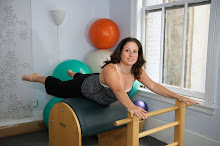

When teaching at JCHS from 2003-2009 it was really important to me for my high school students to gain a vocabulary when talking about their bodies. This wasn't only true of the health/sex ed class, but also of the Pilates, yoga and dance classes.
My adult and teenage students often point to a part of their body and say "this hurts" or "this is tight" without knowing the names of those muscles. This is always surprising considering that the people with whom I work are incredibly knowledgeable about so many other things, just not always about body things.
So I thought I would break it down. The big leg muscles are the hamstrings and quadriceps. The hamstrings and the quads are both muscle groups, not actual muscles. The QUADriceps are made up of four muscles*, and the hamstrings are made up of three muscles** (or it could be four if you consider the biceps femoris two muscles, short and long). The quads are the muscles in front of the upper leg and the hamstrings are the muscles in the back of the upper leg.
The thing that both of these muscle groups do that is so amazing is that they work on the same two joints, the hip and the knee. The quads are all very important in knee extension. The middle quad muscle, the rectus femoris, attaches to the ilium hip bone, so it flexes the hip. The hamstrings are involved in knee flexion and hip extension.
Both these muscle groups cross over the knee joint, so they are really important knee stabilizers. The quads cross over the front of the knee to the patella (knee cap). When the quads are tight, they often pull on the patella, sometimes moving it out of alignment. This sometimes causes clicking or pain but can be managed by rolling out the quads with a roller or pinky ball as well as through stretches. The hamstrings affect the knee from the other side and can be stretched and massaged. Be aware that pain in the back of your knee is something to you should heed. Those are tendons that are asking for attention. Tendons don't stretch like the big part of the muscles. Stretch the big part of the muscle first and you will probably find that your tendons will quiet down.
The other big reason to stretch your hamstrings is, because as I mentioned before, they attach to your hip. When the hamstrings are tight, they can pull on your pelvis, which in turn can cause lower back pain.
The front and back of your leg should balance one another, agonist and antigonist muscles. When walking the quads lift your leg and bring it in front of you. The hamstrings pull the leg behind you. When each muscle is doing its job effectively the other muscle gets to stretch.
So proper gait actually balances the muscles! We will focus on that one another time, in addition to the lower leg muscles and the IT band.
So remember, quads - front of the legs, and hams - back of the legs. Now go for a walk in sensible shoes or no shoes at all. Allow your arms and legs to swing. Let your legs pull the ground underneath you and push the floor away. Then stretch.
*The muscles in the quads are: Rectus Femoris, Vastus Lateralis, Vastus Intermedius, Vastus Medialis. When rehabilitating the knee, we focus on strengthening the Vastus Medialis
**The muscles in the hamstrings are: Biceps Femoris, Semitendonosus, Semimembranosus

Great knowledge, thanks! Can't wait to discover about the mythic IT band- I scarcely believe it exists.
ReplyDelete